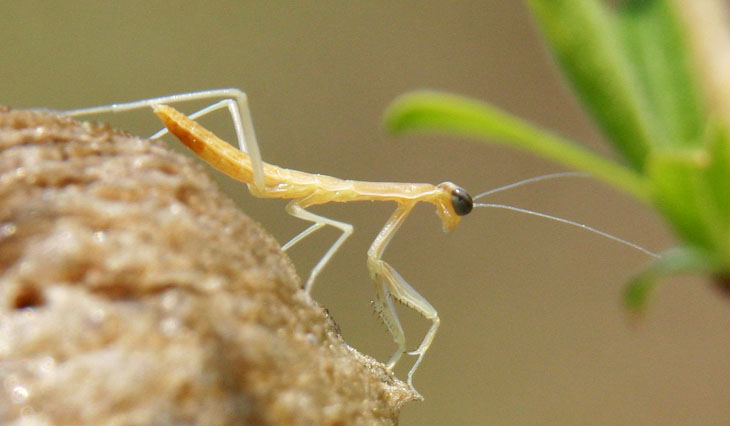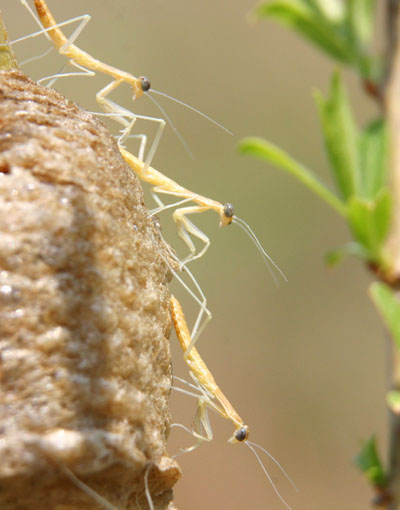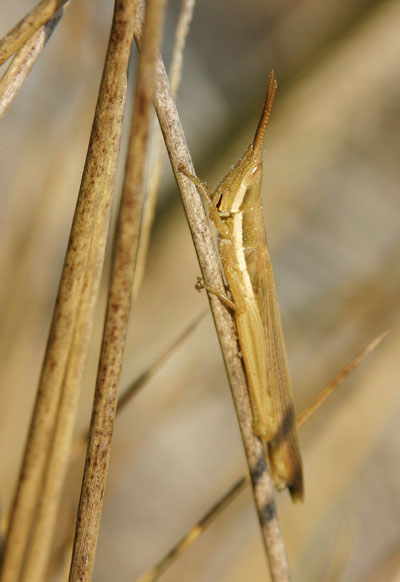The nice thing about macro work is, you really don’t have to go anyplace special.
I walked down to the new local park today, a pretty decent area with a dog park and some paved trails bordering a river. From a scenic standpoint it’s a bit limited, being more “cleared and planted” than natural, but it’s possible to find some areas along the river that will look pretty nice once everything has leafed out – we’re not quite there yet here in NC; the trees are budding and finally getting some green on them, but it’s still a faint haze over the greys and browns of winter. However, more signs of spring are visible, especially if you look close.

I had wandered down to a small, swampy catch basin for water drainage, and in the tall grasses alongside, this praying mantis cocoon had hatched out today. No more than a centimeter long and looking like bits of fluff, these newborns, possibly Chinese mantids (Tenodera aridifolia sinensis,) were swarming all over the immediate vicinity, completely unnoticeable unless you happened to be paying attention. This is something I exploit quite frequently, by the way – I’m so used to looking for photo subjects that I often spot interesting things that most people walk past, oblivious. Occasionally, someone wonders about my foci of attention, but most times I have to actually point out the fascinating little subjects right under their noses. I can’t stress it enough: look carefully at your surroundings.
 The bright conditions today helped no small amount, because I packed light and didn’t bring a tripod, never a good idea when doing macro work. But I was able to shoot handheld at f11, ISO 400, and get excellently sharp images. Once again, depth-of-field gets very short for closeup and macro work, so closing down the aperture to f11 or f16 is almost a necessity, and my friends here (well, they didn’t think so) obliged by lining up in a way that I could get them all in the same focal plane. Even a short variation in distance from the camera, forward or back, would be enough to bring one or another out of sharp focus – notice the cocoon and background leaves. So the goal in macro work is to get the key portions of your subject the same distance from the camera. Technically, this is the same distance from the focal plane, which is the film or sensor – I point this out because tilt-lenses and view cameras can allow some creative options in this regard. Tilting the focal plane can do some neat things to depth-of-field. I have a full-movement 4×5 monorail camera – the old bellows-style, put-your-head-under-the-black-cloth monster, that I just haven’t been masochistic enough to try closeup work with, but it could be very entertaining. Because of the elaborate setup needed for view cameras, focusing and metering and loading the film holders, they’re not for anxious or quick-moving subjects like mantises. Fossils are good macro subjects for view cameras, if you find a placid one.
The bright conditions today helped no small amount, because I packed light and didn’t bring a tripod, never a good idea when doing macro work. But I was able to shoot handheld at f11, ISO 400, and get excellently sharp images. Once again, depth-of-field gets very short for closeup and macro work, so closing down the aperture to f11 or f16 is almost a necessity, and my friends here (well, they didn’t think so) obliged by lining up in a way that I could get them all in the same focal plane. Even a short variation in distance from the camera, forward or back, would be enough to bring one or another out of sharp focus – notice the cocoon and background leaves. So the goal in macro work is to get the key portions of your subject the same distance from the camera. Technically, this is the same distance from the focal plane, which is the film or sensor – I point this out because tilt-lenses and view cameras can allow some creative options in this regard. Tilting the focal plane can do some neat things to depth-of-field. I have a full-movement 4×5 monorail camera – the old bellows-style, put-your-head-under-the-black-cloth monster, that I just haven’t been masochistic enough to try closeup work with, but it could be very entertaining. Because of the elaborate setup needed for view cameras, focusing and metering and loading the film holders, they’re not for anxious or quick-moving subjects like mantises. Fossils are good macro subjects for view cameras, if you find a placid one.
 While walking alongside the fields and tall grasses, there were constant ratcheting zipper sounds – grasshoppers taking short flights with noisy wings. I’m not really sure what purpose this serves, since it attracts attention directly to them, making them easy prey for birds I would think. But perhaps it’s a sexual signal, and its usefulness in reproduction outstrips its hazard? The little guy here, however, is not one of them. Its flight was quite silent, and if I hadn’t been paying close attention to where it landed, its camouflage would have served remarkably well. This is a Cattail Toothpick Grasshopper (Leptysma marginicollis marginicollis,) and as implied by the name, I found it alongside the catch basin. It was perfectly trusting in its ability to blend in, so I was able to approach quite close without causing the anxiety that the mantises displayed. At maybe three centimeters long, only a close inspection would show that this was something other than a leaf.
While walking alongside the fields and tall grasses, there were constant ratcheting zipper sounds – grasshoppers taking short flights with noisy wings. I’m not really sure what purpose this serves, since it attracts attention directly to them, making them easy prey for birds I would think. But perhaps it’s a sexual signal, and its usefulness in reproduction outstrips its hazard? The little guy here, however, is not one of them. Its flight was quite silent, and if I hadn’t been paying close attention to where it landed, its camouflage would have served remarkably well. This is a Cattail Toothpick Grasshopper (Leptysma marginicollis marginicollis,) and as implied by the name, I found it alongside the catch basin. It was perfectly trusting in its ability to blend in, so I was able to approach quite close without causing the anxiety that the mantises displayed. At maybe three centimeters long, only a close inspection would show that this was something other than a leaf.
Coming soon: more from the same day. I added a lot of images to my stock on this little trip.



















































